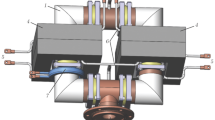Abstract
Results are presented from experimental studies of low-pressure inductive RF discharges (including those with a capacitive component) employed in plasma technology. It is shown that both the RF power absorbed in the plasma and the electron density depend nonmonotonically on the external magnetic field. Discharge disruptions occurring at critical values of the magnetic field and the spatial redistribution and hysteresis of the plasma parameters were observed when varying the magnetic field and RF generator power. The parameters of the plasma of low-pressure (0.5–5 mTorr) inductive RF discharges were investigated, and the discharge properties related to the redistribution of the RF generator power between the plasma and the discharge external circuit were revealed. The experiments were performed with both conventional unmagnetized inductive plasma sources and plasma sources with a magnetic field.
Similar content being viewed by others
References
J. J. Thomson, Philos. Mag. 32, 321 (1891).
W. Hittorf, Ann. Phys. Chem. 21, 90 (1884).
V. A. Godyak, in Proceedings of the 30th EPS Conference on Controlled Fusion and Plasma Physics, St. Petersburg, 2003.
V. A. Godyak, R. B. Piejak, and B. M. Alexandrovich, Plasma Sources Sci. Technol. 11, 525 (2002).
D. C. Miljak and F. F. Chen, Plasma Sources Sci. Technol. 7, 61 (1998).
D. D. Blackwell and F. F. Chen, Plasma Sources Sci. Technol. 10, 226 (2001).
J. Hopwood, Plasma Sources Sci. Technol. 1, 109 (1992).
F. F. Chen, Plasma Phys. Controlled Fusion 33, 339 (1991).
A. F. Aleksandrov, N. F. Vorob’ev, E. A. Kral’kina, et al., Zh. Tekh. Fiz. 64(11), 53 (1994) [Tech. Phys. 39, 1118 (1994)].
K. P. Shamrai and V. B. Taranov, Plasma Sources Sci. Technol. 5, 474 (1996).
J. E. Stevens, in High Density Plasma Sources: Design, Physics and Performance, Ed. by O. A. Popov (Noyes, Park Ridge, NJ, 1996), p. 312.
F. F. Chen, in High Density Plasma Sources: Design, Physics and Performance, Ed. by O. A. Popov (Noyes, Park Ridge, NJ, 1996), p. 1.
R. B. Piejak, V. A. Godyak, and B. M. Alexandrovich, Plasma Sources. Sci. Technol. 1, 179 (1992).
V. A. Godyak, R. B. Piejak, and B. M. Alexandrovich, Plasma Sources. Sci. Technol. 3, 169 (1994).
A. F. Aleksandrov, G. É. Bugrov, K. V. Vavilin, et al., Fiz. Plazmy 30, 434 (2004) [Plasma Phys. Rep. 30, 398 (2004)].
K. V. Vavilin, V. Yu. Plaksin, M. Kh. Ri, and A. A. Rukhadze, Zh. Tekh. Fiz. 74(5), 44 (2004) [Tech. Phys. 49, 565 (2004)].
K. V. Vavilin, V. Yu. Plaksin, M. Kh. Ri, and A. A. Rukhadze, Zh. Tekh. Fiz. 74(6), 25 (2004) [Tech. Phys. 49, 686 (2004)].
K. V. Vavilin, A. A. Rukhadze, M. Kh. Ri, and V. Yu. Plaksin, Fiz. Plazmy 30, 739 (2004) [Plasma Phys. Rep. 30, 687 (2004)].
A. F. Aleksandrov, G. É. Bugrov, K. V. Vavilin, et al., Prikl. Fiz., No. 2, 41 (2006).
A. F. Aleksandrov, G. É. Bugrov, K. V. Vavilin, et al., Prikl. Fiz., No. 4, 54 (2006).
K. P. Shamrai, V. F. Virko, H.-O. Blom, et al., J. Vac. Sci. Technol. A 15, 2864 (1977).
F. F. Chen, J. D. Evans, and G. R. Tynan, Plasma Sources Sci. Technol. 10, 236 (2001).
A. F. Aleksandrov, G. É. Bugrov, K. V. Vavilin, et al., Prikl. Fiz., No. 5, 33 (2006).
Effective Electron-Impact Excitation Cross Sections of Atoms and Ions, Ed. by. Yu. M. Smirnov (Izd. Standartov, Moscow, 1989) [in Russian].
Author information
Authors and Affiliations
Additional information
Original Russian Text © A.F. Aleksandrov, K.V. Vavilin, E.A. Kral’kina, V.B. Pavlov, A.A. Rukhadze, 2007, published in Fizika Plazmy, 2007, Vol. 33, No. 9, pp. 802–815.
Rights and permissions
About this article
Cite this article
Aleksandrov, A.F., Vavilin, K.V., Kral’kina, E.A. et al. Properties of a low-pressure inductive RF discharge I: Experiment. Plasma Phys. Rep. 33, 733–745 (2007). https://doi.org/10.1134/S1063780X07090048
Received:
Accepted:
Issue Date:
DOI: https://doi.org/10.1134/S1063780X07090048



